[English] 日本語
 Yorodumi
Yorodumi- PDB-3pib: Crystal structure of red fluorescent protein eqFP578 crystallized... -
+ Open data
Open data
- Basic information
Basic information
| Entry | Database: PDB / ID: 3pib | ||||||
|---|---|---|---|---|---|---|---|
| Title | Crystal structure of red fluorescent protein eqFP578 crystallized at pH 5.5 | ||||||
 Components Components | eqFP578 fluorescent protein | ||||||
 Keywords Keywords | FLUORESCENT PROTEIN / Red fluorescent protein / beta-barrel / biomarker / Met-Tyr-Gly chromophore / sea anemone | ||||||
| Function / homology | Green Fluorescent Protein / Green fluorescent protein / Green fluorescent protein-related / Green fluorescent protein / Green fluorescent protein / bioluminescence / Beta Barrel / Mainly Beta / eqFP578 fluorescent protein Function and homology information Function and homology information | ||||||
| Biological species |  Entacmaea quadricolor (sea anemone) Entacmaea quadricolor (sea anemone) | ||||||
| Method |  X-RAY DIFFRACTION / X-RAY DIFFRACTION /  SYNCHROTRON / SYNCHROTRON /  MOLECULAR REPLACEMENT / Resolution: 1.154 Å MOLECULAR REPLACEMENT / Resolution: 1.154 Å | ||||||
 Authors Authors | Pletnev, S. / Pletneva, N.V. / Pletnev, V.Z. | ||||||
 Citation Citation |  Journal: Protein Sci. / Year: 2011 Journal: Protein Sci. / Year: 2011Title: Crystallographic study of red fluorescent protein eqFP578 and its far-red variant Katushka reveals opposite pH-induced isomerization of chromophore. Authors: Pletneva, N.V. / Pletnev, V.Z. / Shemiakina, I.I. / Chudakov, D.M. / Artemyev, I. / Wlodawer, A. / Dauter, Z. / Pletnev, S. | ||||||
| History |
|
- Structure visualization
Structure visualization
| Structure viewer | Molecule:  Molmil Molmil Jmol/JSmol Jmol/JSmol |
|---|
- Downloads & links
Downloads & links
- Download
Download
| PDBx/mmCIF format |  3pib.cif.gz 3pib.cif.gz | 559.1 KB | Display |  PDBx/mmCIF format PDBx/mmCIF format |
|---|---|---|---|---|
| PDB format |  pdb3pib.ent.gz pdb3pib.ent.gz | 472.8 KB | Display |  PDB format PDB format |
| PDBx/mmJSON format |  3pib.json.gz 3pib.json.gz | Tree view |  PDBx/mmJSON format PDBx/mmJSON format | |
| Others |  Other downloads Other downloads |
-Validation report
| Summary document |  3pib_validation.pdf.gz 3pib_validation.pdf.gz | 471.2 KB | Display |  wwPDB validaton report wwPDB validaton report |
|---|---|---|---|---|
| Full document |  3pib_full_validation.pdf.gz 3pib_full_validation.pdf.gz | 492.3 KB | Display | |
| Data in XML |  3pib_validation.xml.gz 3pib_validation.xml.gz | 52.3 KB | Display | |
| Data in CIF |  3pib_validation.cif.gz 3pib_validation.cif.gz | 68.8 KB | Display | |
| Arichive directory |  https://data.pdbj.org/pub/pdb/validation_reports/pi/3pib https://data.pdbj.org/pub/pdb/validation_reports/pi/3pib ftp://data.pdbj.org/pub/pdb/validation_reports/pi/3pib ftp://data.pdbj.org/pub/pdb/validation_reports/pi/3pib | HTTPS FTP |
-Related structure data
- Links
Links
- Assembly
Assembly
| Deposited unit | 
| ||||||||
|---|---|---|---|---|---|---|---|---|---|
| 1 |
| ||||||||
| 2 | 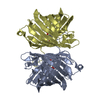
| ||||||||
| 3 | 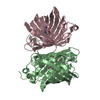
| ||||||||
| Unit cell |
|
- Components
Components
| #1: Protein | Mass: 26935.617 Da / Num. of mol.: 4 Source method: isolated from a genetically manipulated source Source: (gene. exp.)  Entacmaea quadricolor (sea anemone) / Plasmid: pQE30 / Production host: Entacmaea quadricolor (sea anemone) / Plasmid: pQE30 / Production host:  #2: Chemical | ChemComp-GOL / #3: Water | ChemComp-HOH / | Has protein modification | Y | |
|---|
-Experimental details
-Experiment
| Experiment | Method:  X-RAY DIFFRACTION / Number of used crystals: 1 X-RAY DIFFRACTION / Number of used crystals: 1 |
|---|
- Sample preparation
Sample preparation
| Crystal | Density Matthews: 2.28 Å3/Da / Density % sol: 46.12 % |
|---|---|
| Crystal grow | Temperature: 293 K / Method: vapor diffusion, hanging drop / pH: 5.5 Details: 25% w/v PEG 3350, 0.2 M ammonium acetate, 0.1 M BIS-TRIS pH 5.5., VAPOR DIFFUSION, HANGING DROP, temperature 293K |
-Data collection
| Diffraction | Mean temperature: 100 K | |||||||||||||||||||||||||||||||||||||||||||||||||||||||||||||||||||||||||||||
|---|---|---|---|---|---|---|---|---|---|---|---|---|---|---|---|---|---|---|---|---|---|---|---|---|---|---|---|---|---|---|---|---|---|---|---|---|---|---|---|---|---|---|---|---|---|---|---|---|---|---|---|---|---|---|---|---|---|---|---|---|---|---|---|---|---|---|---|---|---|---|---|---|---|---|---|---|---|---|
| Diffraction source | Source:  SYNCHROTRON / Site: SYNCHROTRON / Site:  APS APS  / Beamline: 22-ID / Wavelength: 1 Å / Beamline: 22-ID / Wavelength: 1 Å | |||||||||||||||||||||||||||||||||||||||||||||||||||||||||||||||||||||||||||||
| Detector | Type: MARMOSAIC 300 mm CCD / Detector: CCD / Details: mirrors | |||||||||||||||||||||||||||||||||||||||||||||||||||||||||||||||||||||||||||||
| Radiation | Protocol: SINGLE WAVELENGTH / Monochromatic (M) / Laue (L): M / Scattering type: x-ray | |||||||||||||||||||||||||||||||||||||||||||||||||||||||||||||||||||||||||||||
| Radiation wavelength | Wavelength: 1 Å / Relative weight: 1 | |||||||||||||||||||||||||||||||||||||||||||||||||||||||||||||||||||||||||||||
| Reflection | Resolution: 1.15→50 Å / Num. obs: 314590 / % possible obs: 91.6 % / Redundancy: 5.6 % / Rmerge(I) obs: 0.055 / Χ2: 1.056 / Net I/σ(I): 9.2 | |||||||||||||||||||||||||||||||||||||||||||||||||||||||||||||||||||||||||||||
| Reflection shell |
|
- Processing
Processing
| Software |
| ||||||||||||||||||||||||||||||||||||||||||||||||||||||||||||||||||||||||||||||||||||||||||||||||||||||||||||||||||||||||||||||||||||||||||||||||||||||||||||||||||||||||
|---|---|---|---|---|---|---|---|---|---|---|---|---|---|---|---|---|---|---|---|---|---|---|---|---|---|---|---|---|---|---|---|---|---|---|---|---|---|---|---|---|---|---|---|---|---|---|---|---|---|---|---|---|---|---|---|---|---|---|---|---|---|---|---|---|---|---|---|---|---|---|---|---|---|---|---|---|---|---|---|---|---|---|---|---|---|---|---|---|---|---|---|---|---|---|---|---|---|---|---|---|---|---|---|---|---|---|---|---|---|---|---|---|---|---|---|---|---|---|---|---|---|---|---|---|---|---|---|---|---|---|---|---|---|---|---|---|---|---|---|---|---|---|---|---|---|---|---|---|---|---|---|---|---|---|---|---|---|---|---|---|---|---|---|---|---|---|---|---|---|
| Refinement | Method to determine structure:  MOLECULAR REPLACEMENT / Resolution: 1.154→35.915 Å / Occupancy max: 1 / Occupancy min: 0.04 / SU ML: 0.12 / σ(F): 1.34 MOLECULAR REPLACEMENT / Resolution: 1.154→35.915 Å / Occupancy max: 1 / Occupancy min: 0.04 / SU ML: 0.12 / σ(F): 1.34
| ||||||||||||||||||||||||||||||||||||||||||||||||||||||||||||||||||||||||||||||||||||||||||||||||||||||||||||||||||||||||||||||||||||||||||||||||||||||||||||||||||||||||
| Solvent computation | Shrinkage radii: 0.9 Å / VDW probe radii: 1.11 Å / Solvent model: FLAT BULK SOLVENT MODEL / Bsol: 25.794 Å2 / ksol: 0.417 e/Å3 | ||||||||||||||||||||||||||||||||||||||||||||||||||||||||||||||||||||||||||||||||||||||||||||||||||||||||||||||||||||||||||||||||||||||||||||||||||||||||||||||||||||||||
| Displacement parameters | Biso max: 58.79 Å2 / Biso mean: 17.0049 Å2 / Biso min: 5.76 Å2
| ||||||||||||||||||||||||||||||||||||||||||||||||||||||||||||||||||||||||||||||||||||||||||||||||||||||||||||||||||||||||||||||||||||||||||||||||||||||||||||||||||||||||
| Refinement step | Cycle: LAST / Resolution: 1.154→35.915 Å
| ||||||||||||||||||||||||||||||||||||||||||||||||||||||||||||||||||||||||||||||||||||||||||||||||||||||||||||||||||||||||||||||||||||||||||||||||||||||||||||||||||||||||
| Refine LS restraints |
| ||||||||||||||||||||||||||||||||||||||||||||||||||||||||||||||||||||||||||||||||||||||||||||||||||||||||||||||||||||||||||||||||||||||||||||||||||||||||||||||||||||||||
| LS refinement shell | Refine-ID: X-RAY DIFFRACTION / Total num. of bins used: 23
|
 Movie
Movie Controller
Controller




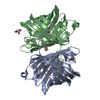
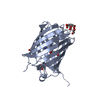




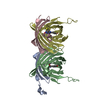
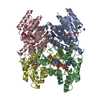
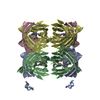
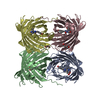



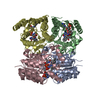

 PDBj
PDBj




